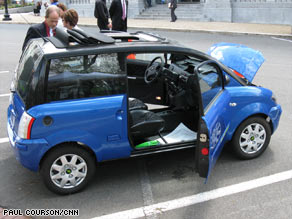Ahem....WHAT did I say??????????????????????????
http://www.marketwatch.com/News/Story/Story.aspx?guid=%7bBDD5090C-E3F5-49E7-AE46-83DFB05AC897%7d&siteid=nbkhPRESS RELEASE
EEStor, Inc. Announces an Update and a Correction to Last Week's Press Release on Their Relative Permittivity Certification Results
Last update: 5:37 p.m. EDT April 27, 2009
CEDAR PARK, Texas, April 27, 2009 /PRNewswire via COMTEX/ -- CEDAR PARK, Texas, April 27 /PRNewswire/ -- EEStor, Inc. announces an update and a correction to last week's press release on their relative permittivity certification results. The update is on temperature range certification results and also correcting the information on Dr. Edward D. Golla, Ph.D.
The third party certification tests were witnessed by Dr. Edward D. Golla, Ph.D., an independent consultant. The test results were performed on EEStor's hot pressed dielectric layers produced from both their patented and patent pending Composition Modified Barium-Titanate Powders and their production line.
Dr. Edward D. Golla, Ph.D. certificated that EEStor's hot pressed dielectric layers have met and/or exceeded a relative permittivity of 22,500 over a temperature range of -20 and 65 degrees centigrade.
EEStor feels this is a huge milestone which opens the advancement of key products and services in the electrical energy storage markets of today. The automotive and renewable energy sectors are a few of the key markets that would benefit greatly with the technology.
About Dr. Edward D. Golla, Ph.D.
Edward D. Golla graduated from the University of Texas at Austin in 1971 with a Ph.D. in Analytical Chemistry. He has been an employee of and later a consultant for TRACOR Inc. Dr. Golla has also taught Chemistry and Instrumental Analysis at schools such as St. Edwards University and Southwestern University of Georgetown, TX. He has been an employee of Texas Research International since 1975 and is currently Laboratory Director at that company
Company background
EEStor, Inc. develops solid-state electrical energy storage units (EESU's) in the form of batteries and capacitors. This technology has a wide variety of application use which includes with the added benefit of being longer lasting, lighter, more powerful, and more environmentally friendly than current technology in use.
SOURCE EEStor, Inc. Copyright (C) 2009 PR Newswire. All rights reserved





 If you've been scratching your head about
If you've been scratching your head about 






